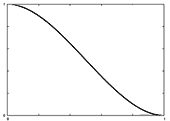Geometric Distance Algorithm for Finding Initial Vertex
Weights
![[hr]](black.png)
This initial weight guessing algorithm uses mesh connectivity
and geometric distance rather than Euclidean distance to decide
which joints should influence a given vertex. This prevents a joint
from influencing a vertex that, although very close in Euclidean
distance, is not near to the joint in terms of the mesh. A classic
example of this is in the knees of a biped character. The vertices
at the inside of the knees may be very close to each other but you
would never want a left knee joint to influence a right knee
vertex, or vice versa.
The geometric distances between vertices is precomputed using
Dijkstra's algorithm using each vertex as the source. This is an
NxN matrix, for a mesh of N vertices. This is
one way to compute All Pairs Shortest Paths for a graph, or in my
case, a mesh.
So, you might ask, how do you compute distance from a vertex to
a joint? The answer, cut the mesh with the joint coordinate plane
and the store the "ring" of vertices in the mesh that approximate
the plane-mesh intersections. This ring of vertices are at distance
0 from the joint, then use the precomputed All Pairs Shortest Paths
matrix for the rest.
Below is a psuedocode outline of the algorithm:
/* Cut the mesh by each joint and get the ring of vertices. */
for each joint j in skeleton,
Cut the mesh by the plane defined by j's coordinate system
Store list of n vertices in the mesh that best approximate
the n plane-mesh intersections
/* Find initial influence set and weights for each vertex */
for each vertex v in mesh,
Find the geometric distance d to each joint by finding the nearest vertex
in each plane-mesh approximation list
do,
if the current closest joint dj = min( D ) < Threshold,
Add joint j to v's influence set with weight = dj
D = D - dj
until we have selected the maximum number of influences
Maximum-Distance = min( D )
for each influence j,
weightj = F( weightj / Maximum-Distance )
For the weight normalization function F I use a Cubic
Hermite Spline. I tried a linear falloff function as well but this
one produced qualitatively better results.

![[hr]](black.png) Luke Tokheim, <ltokheim@cs.wisc.edu>, May 13,
2003
Luke Tokheim, <ltokheim@cs.wisc.edu>, May 13,
2003